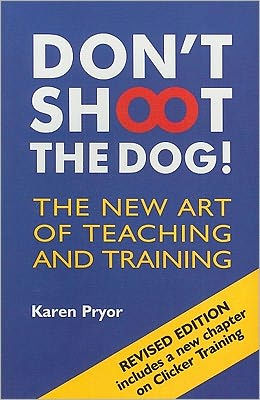Dr. Joseph Barber
I was sorting through some old boxes at home the other night when I stumbled across a copy of a book I was given when I worked as a Research Fellow at Disney’s Animal Kingdom. The book is called “Don’t Shoot the Dog”, and it focuses on how you can use positive reinforcement as a tool to train animals. Zoos and aquariums engage in lots of animal training, and much of this is done to help improve the welfare of the animals, and so there were plenty of opportunities for keepers to train animals at Disney’s Animal Kingdom. Here are some examples of training in a zoo setting: https://www.youtube.com/watch?v=z2a3UIu3lJc.
At home, if you have ever given your dog a treat when it sits down on command then you are using positive reinforcement. In fact, if you have ever enthusiastically and immediately thanked a faculty member for writing a reference letter for a job application at short notice, then you have also used positive reinforcement. When it comes to animal training, humans are just as animaly as all the other animals out there. Positively reinforcing a behaviour increases the likelihood that the behaviour will occur more frequently in the future. Effective positive reinforcement increases the energy in the room when you are working with other people or animals, and creates a more positive environment for whatever project you are working on. If you can find the right reinforcer, and can provide it immediately after the behaviour you want to promote has been performed, then you on your way to being able to improve your relationships with peers, advisors, students in your classrooms, bosses, family, and your various companion animals.
When thinking about career exploration and the job search, there are many situations where positive reinforcement can be helpful. There are also many times where people miss opportunities to use this approach. Here are some common issues:
- You speak with an alum at a networking event, but don’t send a brief thank email within 24 hours.
- Your advisor rushes to write a reference letter for you, but you don’t acknowledge the extra work they did, thank them, or let them know when you got the job.
- A recruiter emails you with an update on a position you are applying to, but you don’t respond to their email promptly.
A positive reinforcer tells the recipient that the behaviour they just performed is good. The more you reinforce the behaviour, the more often it will occur. However, not providing any reinforcement, or providing it too long after the behaviour is performed, gives the recipient no information, provides no positive energy, and so there is no impetus for them to do more of the behaviour in the future. When you are looking for jobs or internships, this means thanking people often and quickly, and being prompt with your upbeat responses when you see people working on your behalf at any point in the job search process.

If you are looking for an easy summer read, then take a look at this book, and see how you might be able to take proactive steps towards maximizing the many benefits that positive reinforcement can have as you engage with your network.

